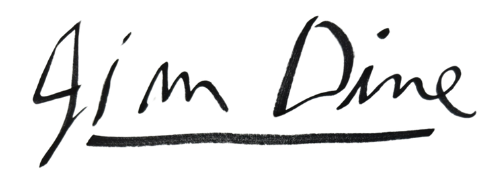NEW YORK SUN: Pop Art Pioneer Jim Dine’s New Show Hearkens Back to His Origins as an Innovator
Dine expresses his fascination with the tensions between abstraction, two-dimensional representation, and the presence of things.
DAVID HIROSHI JAGER, Thursday, March 14, 2024
‘Jim Dine: The 60’s’
125 Newbury, 395 Broadway, New York
March 15 through April 20, 2024
A pioneer of pop art and one of the early instigators in the “Happening” movement, Jim Dine, is probably best known for his “heart” series. Once as ubiquitous as Keith Haring’s dancing figures, they have perhaps misdirected attention away from a 60-year career rich with other pioneering work. Mr. Dine, who by his own admission is compulsively productive, has been especially prolific since the pandemic, churning out drawing, painting, and even monumental sculpture.
His new show at 125 Newbury, however, hearkens back to his origins as an innovator in both the “Happenings” and Pop Art movements. Featuring more than a dozen paintings, sculptures, and works on paper produced between 1959 and 1973, they also show how his preoccupations have remained remarkably consistent.
Mr. Dine has always been torn between his love for the lofty ideals of high art and his suspicion of them. This no doubt stems from his youthful grounding in the blunt vernacular of tools, when he worked for many years in his grandfather’s Ohio hardware store. It is this tension between his rapacious, some would say romantic, mind and a terse Midwestern sensibility that serves as the driving force of his work. He continuously attempts to marry the most sublime concepts of art with the ordinariness of everyday things.
Mr. Dine arrived at New York in 1959, sharing an Upper East Side apartment with his friend Claes Oldenberg. Together, they scoured the streets for cast off artifacts he would repurpose in painting and sculptures. The summer of 1959 also proved traumatic, as he suffered through two separate crashes in quick succession.
This resulted in the opening painting of the show, “Car Crash,” which features raw masses of black furiously painted over burlap together with somber black crosses. It encapsulates Mr. Dine’s excessive, always messy attempt to grapple with feelings and events. Mr. Dine would paint himself silver and impersonate a car during a happening he mounted during this same period.
Along with his driven emotionalism, the show also features Mr. Dine’s more Apollonian side. The signature painting of the series, “The Studio (landscape painting),” is a cheeky send up of abstract expressionism. A long rectangular canvas features strips of different gestural styles, almost like the sample swatches from a color book placed side by side.
Even so, the juxtaposition is not unpleasant, recalling the improvised, even randomized compositional techniques used by other painters from the era. There is a small shelf attached to the bottom, however, holding an assemblage of actual bottles, glasses and other glassware. A literal still life is contrasted with a send up of abstraction, a contrast Mr. Dine seems to relish.
It continues with a later painting, “Things in Their Natural Setting, First Version” which appears at first glance to be a painting of a green grassy field but is actually a mass of abstract gestural brushstrokes — a “field” of color, get it? Tools — a trowel, drill bit, screwdriver, exacto knife, scrub brush, and mallet — are suspended by lengths of wire from the painting’s top and interrupt the surface.
Mr. Dine’s favorite elements are at play here: the dialogue between abstract expressionism and representation, the juxtaposition of the represented and the real. Once again, Mr. Dine expresses his fascination with the tensions between abstraction, two-dimensional representation, and the presence of things. That it manages to be fresh and jarring some 50 years later is saying something.
The same alacrity plays out in the bric-a-brac paintings in this show, in which everyday stuff — neckties, boots, hammers — are affixed to surfaces with his cool Dadaist bravado, as in “Five Silver Ties”. They are very much of the sixties in their workmanlike, almost minimalist sensibility, but also in the way in which they intentionally misread their own material intentions.
Cloth appears hard-edged and metallic, while his sculpture of a boot appears anthropomorphic, and the most prosaic of tools suddenly seem organic. These reach an inflection point with “4 ½ palettes with mirrors”, where Dine represents the thing that makes a painting as a painting, juxtaposed with drawings of electric fans. The work appears intensely intellectual and deeply intuitive all at once. Which, I think is the point.
Mr. Dine’s art and his use of objects, both brash and tongue-in-cheek, appear to be rediscovered with the same enthusiasm and bafflement every five years or so. Yet he persists, going strong like other New York artists of his indefatigable generation. Mr. Dine, who is 87, works in studios scattered between a farm in the Pacific Northwest, New York, the 14 arrondissement of Paris, and Gottingen, Germany.
Still possessed with the same exuberant “bad boy” energy that powered his art career in the 1960s, one may wonder where the impetus for his continued productivity hails from. This show is a useful look back at the ideas that launched a career which appears to continue unabated.


